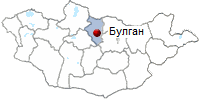Elsen tasarkhai sand dunes. Bulgan aimag.
THE REGIONS OF MONGOLIA
BULGAN AIMAG.
ELSEN TASARKHAI SAND DUNES


Bulgan aimag is situated in the North, in the territory of the Khangai mountain forest steppe zone. Bulgan aimag borders on the North with the Russian
Federation. Bulgan aimag is a curious mixture: the south is dry grassland and the north is green and has enough forest to support a small timber industry;
scattered in between are about 50,000 hectares of wheat and vegetable crops - Mongolia's agricultural heartland - and Erdenet, Mongolia's largest copper mine.
The ethnic groups comprise Khaikh, Buryat and Russians.
Soil is sandy with semi-desert features in the South
of the aimag. A small mountain range, the Biirengiin Nuruu, bisects the aimag, and though it only reaches a maximum altitude of 2058m, it provides plenty
of lush habitat for wild animals and livestock. High mountains include: Bulgan Khan Uul, Buregkhangai, Dulaankhan.
Elsen tasarkhai is a part of the Mongol Els sand dunes, which
stretchs along the Tuv, Uvurkhangai and Bulgan provinces. The sand dunes are
totally 80 km long. Dividing the southern part of the sand dunes with the
so-called northern Mongolian sand, Khugnu Tarna is a main road. River Tarna
flows in the western part of the sand dunes and it is sodden under its surfaces,
so shrubberies such as willow, elm, dogwood, shrubbery grow there. In the north,
there is the rocky and woody mountain “Khugnu khan”. Ikh Mongol which defines
the central point of Mongolia lies in the south of the sand dunes. The widest
section of the sand dune is located in the Ikh Mongol mountain area and covers
an area of 9-10 km2. It is not loose sand so that half of the Ikh Mongol sand is
covered with plants.
Elsen Tasarkhai is located in Burd soum of Uvurkhangai province and 280km
from Ulaanbaatar on the way to Kharkhorin. It can be translated as “sand
fracture” and it continues 80 km long, 5 km wide in the South of the Khogno Khan
National Park.
PLACES TO VISITED.
- Hogno Haan uul. Although it's just off the main Ulaanbaatar-Kharkhorin highway, this nature
reserve sees relatively few visitors. Its arid terrain of rocky semi-desert is good for short hikes and there are a few old temples to explore, both ruined and
active. At the southern foot of the mountain are the ruins of Ovgon Khiid, built in 1660 and destroyed (and the monks massacred) by the armies of Zungar Galdan Bochigtu, a
rival of Zanabazar's in 1640. About 10 monks reside here in the summer months. The head lama is a charming woman who professes soothsaying abilities.
- Ovgon-Khiyd Monastery. The monastery is located in the mountains of Khogno-Khan 257 km away from Ulan-Bator, on the way to
Arvaykheer, 173 km away from Arvaykheer and about 75 km away from Kharkhorin.
ADDITIONAL INFORMATION:
PAGES OF THE PICTURE ALBUM
|